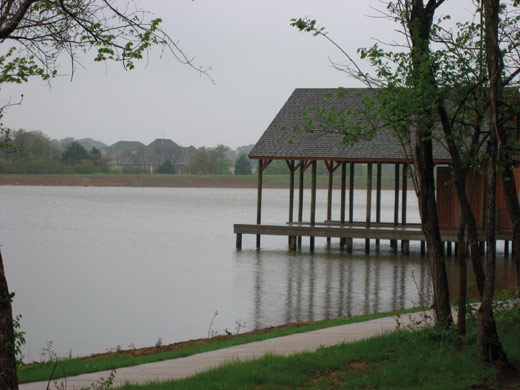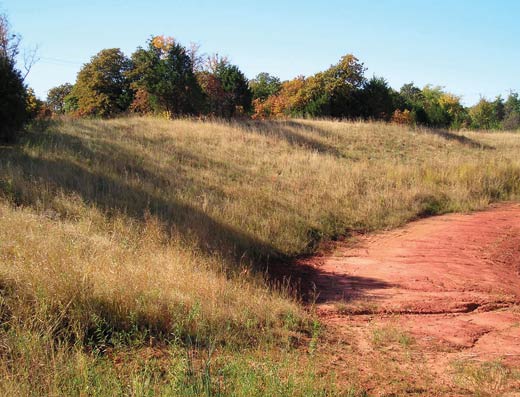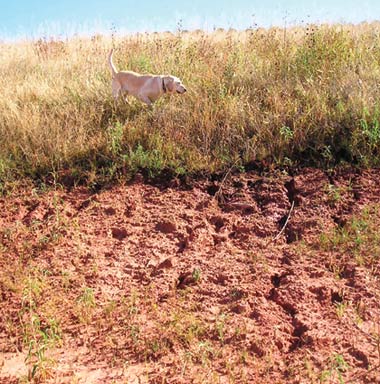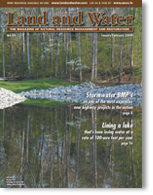Features Available Online
ECBs Offer Ideal Solution For Shoreline Stabilization
by Brian Baker

The sidewalk in the foreground is a demonstation of how ECBs can be used in lieu of sod along sidewalks and streets. TES seeded tall fescue and laid the ECBs to protect the sidewalk from undermining.
Lakeside of Oakdale is an up-scale residential development located in northeastern Oklahoma City, Oklahoma. At the center of the 44 home development is a 23-acre, man-made recreational lake. The watershed for the lake is contained within the boundaries of the development, with no run-off entering the lake from an off-site source. The watershed prior to clearing and construction was typical of the crosstimbers region, a dense mix of blackjack and post oaks with eastern red cedars and tallgrass breaks in the upland areas, with hickory, pecan, willow, box elders, and thickets of blackberry and greenbriar in the lower areas. The watershed was approximately 80% dense woodland and 20% open grassland before construction. The lake was dug on the lowest area of the project and excavated material was used for the construction of the dam. No fill was brought in to construct the dam.
The developer, Turner and Company of Edmond, Oklahoma, wanted to make sure that the slopes in the development and especially around the lake's perimeter were stabilized and vegetated as the lake filled with water and construction of homes began. Because the storm sewer system drains into the lake, many Best Management Practices (BMPs) are used and maintained throughout the project. Silt fence and construction entrances are required of the builders at each lot where appropriate and inlet protection devices are used at curb-style inlets and flumes. There is also a sizeable area around the lake that is 'common area' and has been seeded to serve as a grassy buffer between construction activities and the lake. Tallgrass Environmental Solutions, LLC (TES), a landscape contracting company that focuses on erosion/sediment control and sustainable landscaping, was contracted to determine the BMPs for the slopes on the lake to ensure stabilization, as there was ample opportunities for soil erosion on its 3:1 and greater slopes.
“When we first saw the plans on paper—and at that point no dirt had been moved—the project looked much smaller in scale,” said Joshua Rasp, vice president and project manager of Tallgrass. “Once the area was cleared for development and the approximately 1,300 feet long dam of the lake was built, almost all of the slopes were greater than 3:1 and I knew we would have to overcome some issues.”
| Tallgrass Environmental Solutions, LLC (TES), a landscape contracting company that focuses on erosion/sediment control and sustainable landscaping, was contracted to determine the BMPs for the slopes on the lake to ensure stabilization, as there was ample opportunities for soil erosion on its 3:1 and greater slopes. |
Some of the key issues Mr. Rasp would have to overcome included high ground water that caused the clay soil, which was abundant on this project, to clod and not spread evenly. Also, the lake’s sloped topography made it difficult to utilize the equipment needed to effectively prepare the ground. Plus, with the lakeside slopes facing in all directions, TES needed a vegetative stabilization solution that would flourish under different levels of exposure to sunlight which effects seed germination. Finally, because of the high water table, water would often seep out of the cut slopes causing the soils to soften. This makes it more difficult to run equipment on the slope and may actually cause the slope to slump, requiring subsequent repair.
To implement an effective solution for the soil preparation issues, Mr. Rasp selected several products to use on the slopes. However, there was one major obstacle he had to overcome before that could happen. Normally in this area of the country, Bermuda grass sod is the application that is selected most often because of its availability and it is the most economical. Therefore, convincing the developer to use an alternative application hinged on one thing—cost. Rasp suggested a cost-effective solution of seeding the bare slopes and shoreline with native grass and wildflowers that could be customized for both upland and wetland applications. To ensure vegetative growth he selected paper mulch, supplied by Vance Brothers, for use on the flatter areas. A combination of the paper mulch and Landlok® SuperGro® Erosion Control Blankets (ECBs), manufactured by Propex Geosynthetics, were used on all other areas. The erosion control blanket was selected because it allows more sunlight, air and water to reach the seeds and vegetation, prompting fast vegetative growth and superior stabilization.

The first fall after planting - the pictured slope received ECBs.
These particular erosion control blankets are constructed of lightweight geocomposite material with a degradable polypropylene scrim and a thin web of green soil reinforcement polypropylene fibers. These elements allow the mats to control erosion on slopes, and also enhance seed propagation, leading to an abundance of vegetation, which is a key element to shoreline stabilization.
The installation took place during the early part of April 2005. To prepare the slopes for seeding, the sandy loam soil was dragged and, in places, hand graded, to create relatively smooth slopes. The seed mix included over 60 different varieties, including Big Blue Stem Grass, Little Blue Stem Grass, Indian Grass, Grama Grasses (blue and Sideoats grama), and a wide variety of wildflowers as well as forbs. For the hydroseeding, a Kincaid Pro Series 1200 with water pulled from the lake to fill the machine—as there was no well or municipal water source available yet—was used.
| Within three weeks after installation, the site experienced at least three separate rain events that dumped between 3 to 4 inches of rain in a 24-hour period. |
The seed was planted with paper mulch and covered with erosion control blankets. A total of 15,000 square yards of erosion control blankets were placed over the sprayed on material. Due to the geometry of the slopes, it was decided to install the ECB’s parallel to the slope, which took a four man crew only 3 days. In all, the seeding and netting took approximately 2 weeks.
“Installing the ECB’s parallel to the slope is an acceptable method of installation because this specific RECP does not require check trenches,” explained Rasp. “By installing the ECB’s parallel to the slope (sideways), we were able to preserve the grade of the hill which, more than likely, would have been wrecked with a sod installation, saving us time and effort.”

“Sam” investigating a slope that received hydromulching and SuperGro ECBs. ECBs lock seed and fertilizer into the soil and hold the system in place for maximum germination and protection from runoff.
After installation, the blankets were watered, which forced the green, hair-like fibers into the soil, thus forming an instant root structure to control erosion and hold the seed in place. Within three weeks after installation, the site experienced at least three separate rain events that dumped between 3 to 4 inches of rain in a 24-hour period. “With the amount of rain that was dumped on us over a 3-week period, I’m pretty sure we would have seen a lot of soil erosion along the sod seams,” said Rasp. The areas where the blankets were installed did not erode and kept the seed in place for proper germination and growth. Mr. Rasp reported that by September 2005 he recognized extremely uniform growth through the erosion control blanket material, and he was confident that nearly all seed types germinated and were well established. He also noticed that the blankets did a great job of controlling erosion and stabilizing the slope for vegetative growth. He was especially pleased that his company did not have to return to the site and repair any of the slopes on which the blankets were used. ![]()
For more information, contact Brian Baker, bbaker@johngroup.com or visit www.geotextile.com.

